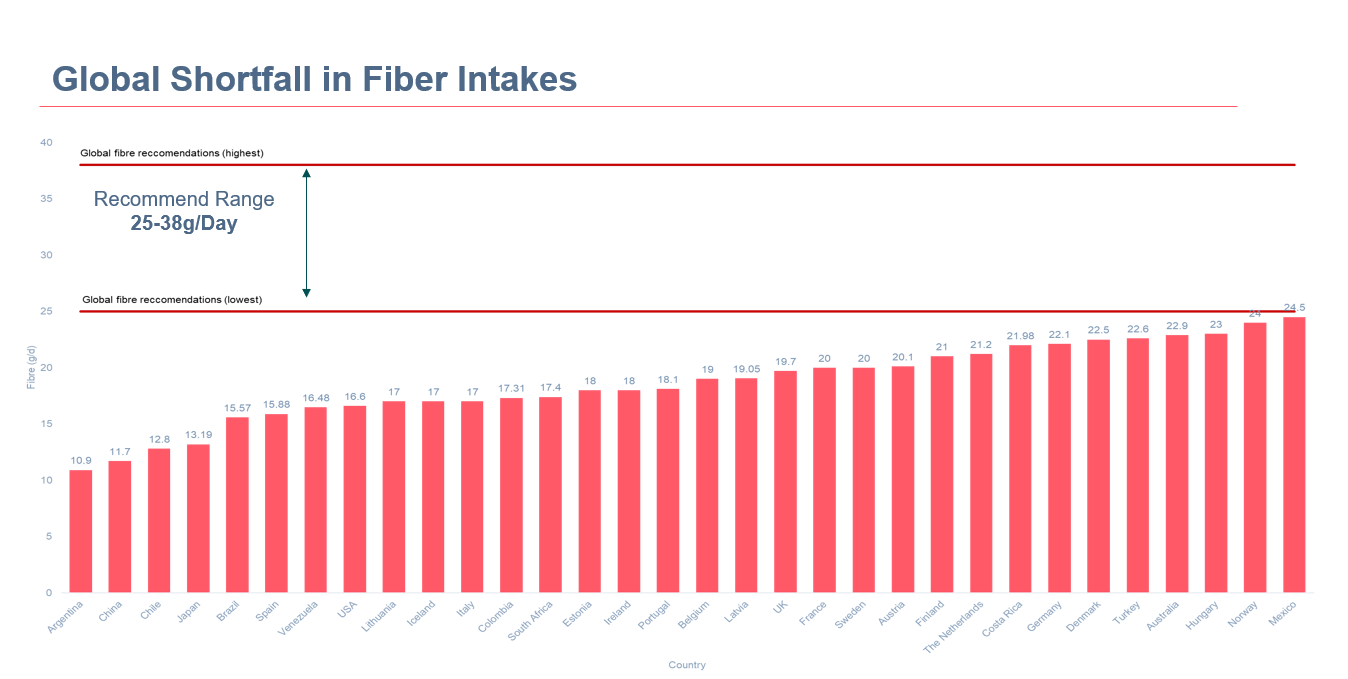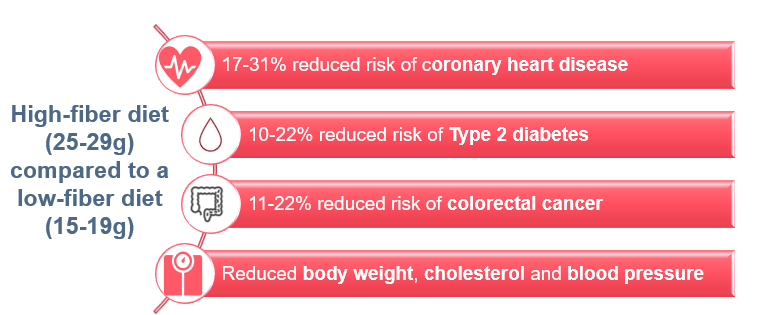Personalized Nutrition: Innovating for Health and Wellness Across All Life Stages
By Melissa Kaczmarczyk, Principal Scientist, Global Nutrition
Have you ever tried on a piece of clothing labeled “one size fits all,” only to find that “all” doesn’t seem to include you? It’s the same with nutrition—what’s suitable for one person may not be for the next. That’s something we are increasingly recognizing as we study the effects of nutrition on men and women across all stages of life.
Consumers recognize it, too. Hence, there is a high demand for food and beverage products tailored to their unique dietary needs. Unfortunately, in many cases, this demand is going unmet. The flip side is that far-sighted producers have new opportunities to tap into an expanding market with suitable formulations for personalized nutrition products.
Let’s investigate the meaning of “personalized nutrition,” delve into the science behind it, and learn why this is an emerging field you cannot afford to ignore.
Understanding Personalized Nutrition
As a term, “personalized nutrition” lacks a specific definition. It could be as broad as products created for widely practiced diets such as ketogenic or Mediterranean. It might be more specific to a need state, such as a diet for persons with diabetes or food and beverages nutritionally formulated specifically for menopausal women. It may even refer to an individually planned menu based on one’s unique needs.
Life Stage is another category to look at for personalized nutrition. For example, adolescence is a critical period for bone building; the pre-puberty growth spurt is when about 25% of our bone mass is built, so there’s a heightened need for calcium.1 In adulthood, we enter a period of bone maintenance where there’s a balance between calcium retention, building of bones, and replacing what’s lost. By the time you approach 40, you start losing that bone mass, so your calcium requirements change again.2
So, even from this one example, it’s clear that there is great potential to succeed with products specifically for those different periods in our lives. Let’s now shift focus from calcium to fiber. As you’ll see, it’s a crucial nutrient; how we use it changes as we age, but its impact on our bodies cannot be overstated.
The Science Behind Personalized Nutrition
Not to make you squeamish, but there are billions and billions of microscopic “bugs” living in and on our bodies, most of which are in our gut. Estimates range to as high as 100 trillion bacteria and microbes calling our digestive tracts home; we call this the microbiome.3 They can be either beneficial or detrimental, depending on your balance. We want to maintain a healthy microbiome, though we don’t fully understand what that is yet. We do know that to be healthy, we want a diversity of microbiota (the “residents” of your microbiome), and we want to feed the good bacteria.
So, what do we feed them? For starters, fiber. Our microbiota “eat” fiber, fermenting it and producing short-chain fatty acids as byproducts, which are highly beneficial for our well-being.
To better understand how fiber interacts with our gut microbiota, we conducted a study with a lab-based model of the digestive system. It's called SHIME® (Simulator of Human Intestinal Microbial Ecosystem), and it simulates different parts of the intestinal tract in containers in a lab setting.4 Using human fecal samples, we can test how various nutritional elements would react in the body.
We used samples from babies, adults, and older adults and examined how supplementing soluble corn fiber affected measurables like microbiota populations, gut membrane integrity, and cytokine production. We found that soluble corn fiber did change the microbiota.
We observed positive shifts in microbiota, specifically Bifidobacteria, and increases in short-chain fatty acids across the board with all three groups of samples. Those fatty acids then affect our bodies in different ways. That means everything from signaling molecules to different hormones to immune molecules and cytokines, and even neurotransmitters. They can also trigger anti-inflammatory and immune effects.
I mentioned neurotransmitters, and that moves us to the idea of the gut-brain axis. Emerging research is helping us better understand the relationship between fiber and the brain. Indeed, we're seeing fiber may have benefits in areas like cognition and mood, and that’s throughout the life cycle. It’s an exciting new field of study, and we’re constantly learning more.
The Fiber Gap and Its Impact
Given what we know about fiber and its importance to overall health, you’d think it would be a given that fiber be top of mind for consumers. The truth is there is a fiber gap globally. The World Health Organization recommends consuming about 25 grams of dietary fiber per day, based on a review study that showed benefits of decreased risk of cardiovascular disease, reduced risk of diabetes, and weight reduction, among other benefits, with more benefits the more you increase your fiber intake.5 That number varies depending on your age and biological gender, but 25 grams is a good target.
In actuality, very few people are even approaching 25 grams. A 2023 study published in the British Journal of Nutrition found that fewer than 10% of American adults are reaching their daily fiber intake target.6 Data from the WHO reveals a worldwide fiber intake shortage; in the US, the average person has a daily intake of 16.6 grams. There is a fiber gap in our diet globally, which needs to be addressed.

Anyone involved with nutrition encourages the consumption of whole foods first to increase fiber intake. The reality is that it's not always possible with busy lives, dietary needs, and socio-economic situations. And, looking at different age groups, there are barriers specific to, say, children or older adults for fiber intake. This is where fortification can help bridge the gap.
Some consumers have a growing distrust of so-called “ultra-processed foods.” The level of processing doesn’t indicate how nutritious a food is. The Nutrition Facts Panel does. There is a place for processing, and many UPFs are very healthy thanks to fortification.
It’s a question of meeting the consumer where they are. Maybe that takes the form of a protein brownie or cookie; there’s no point adding nutrients to something they aren’t consuming. If something like a brownie has added fiber and lower sugar—and we have solutions for that too with our range of sweeteners—that could help across lifecycles. It’s a healthy food addressing a worldwide health crisis that just happens to have an appealing brownie flavor. The important thing remains that we get consumers the nutrients they need in the form they want.
Innovations in Personalized Nutrition
At Tate & Lyle, we are always looking for innovative solutions. In pursuit of that, since 2021, we have been part of IMAGINE, an international consortium of academics and commercial industry partners working together to solve a problem, in this case, making personalized nutrition more accessible and wider spread.
The research shows that through personalization, you can create tailored, healthier products and make them tastier and in a format that people will eat and can get at the grocery store or wherever is convenient. Combining better products with increased accessibility results in more effective health outcomes and behavioral changes, such as getting more fiber in their diet.
This particular project utilizes 3D printing. It’s not unlike the process of building 3D models with plastic, except we’re printing food. The equipment can produce a snack or other food product in layers made of specifically chosen nutritional inputs, allowing for unprecedented levels of personalization. Tate & Lyle scientists have provided their expertise on fibers, sweeteners, and texturants. Together, we’re learning how these ingredients function in a 3D printer with the goal of producing on-demand nutritional products.
This technology has excellent potential for hospitalized or home-bound patients with caretakers, ensuring they're meeting their specific dietary needs. It looks like it could be a possibility for the military, too, to produce different food items in the field. Perhaps even vending machines dispensing customized nutritional aids based on your unique data. This kind of hyper-personalized nutrition is an exciting field, and we are proud to be part of it.
Meeting Consumer Nutrition Needs Today
We also look at personalized nutrition as a tool to help our customers meet the challenges of consumer trends in food and beverage. For example, we’re learning to navigate the new playing field created by GLP-1 medications like Ozempic®.
We see a role for fiber and nutrition products for those on anti-obesity medications. Part of the issue is GLP-1 users don’t eat large servings; the GLP-1 hormone, which this class of drugs mimics, convinces the brain it’s full on a smaller portion of food and causes the stomach to empty more slowly. There's an opportunity for manufacturers to create products in smaller portions and make them more nutrient-dense.
Even outside GLP-1 diets, weight management is important to many consumers. For that kind of diet, substituting fibers for more complex carbohydrates or sugars automatically brings the calorie count of that product down, and that's only one way fibers can help with weight management. We have research showing polydextrose can decrease energy consumption at a subsequent meal and decrease hunger.7,8
From a consumer standpoint, the perceived value of a product is crucial, especially when it comes to smaller portion sizes. Consumers still want to get those benefits of the larger portion sizes, not just the nutrition but also the full sensory experience of great taste, texture and mouthfeel or at least a strong approximation.

Partnering on Personalized Nutrition with Tate & Lyle
We’re very excited at Tate & Lyle about our fibers, especially for their prebiotic potential—meaning their value as food for the gut microbiota. A prebiotic is a fiber fermented by bacteria, increasing positive bacteria populations and providing some of the other health benefits we’ve discussed. Some fibers don’t do all that; they're good at providing fiber, but they're not necessarily prebiotic fibers. We’ve achieved substantiation and status for two of our products, STA-LITE®* and PROMITOR®, which can now be considered prebiotics.
In our portfolio, we have GOS, FOS, SCF, and PDX. Let’s decode the acronyms:
- Galactooligosaccharides (EUOLIGO® GOS)
- Fructooligosaccharides (EUOLIGO® FOS)
- Soluble Corn Fiber (PROMITOR®)
- Polydextrose (STA-LITE®)
While they are all fibers, they each behave differently in the body. They're fermented by different bacteria at different speeds in our intestines, which can result in different tolerances as well. They share many of the same benefits, but they also have those that are specific to the particular fibers.
Take soluble corn fiber. It has a calcium absorption benefit, so one might explore using it in, say, a delicious smoothie for older women to promote calcium absorption. We work with our customers to help identify opportunities like this.
It’s that variety of products and our deep understanding of how they work that makes Tate & Lyle a great partner for anyone looking to produce personalized nutrition food and beverage products. We work with our customers to help identify those opportunities, and we can take solutions to customers proactively and come up with some ideas for those different stages and need states that are in some way overlooked or underserved.
We’ve talked a lot about fiber, but there’s more to creating a winning formulation than personalized micro- and macronutrients. You can also personalize mouthfeel, sweetness, and flavor, making it more acceptable to individual tastes. Not everyone has the same palette (how boring would it be if we did!), so by making those adjustments, you can help people get those vital nutrients in a way they’ll enjoy. Nothing tops taste for consumers. But when you can combine incredible taste with the health benefits they truly need, that’s a formulation for success.
* This statement has not been evaluated by the Food and Drug Administration. Please be advised that Tate & Lyle is not responsible for any claims made by its customers regarding polydextrose as a prebiotic. Customers are encouraged to conduct their own risk assessments and due diligence regarding the use and claims of polydextrose as a prebiotic. It is the customers’ responsibility to ensure compliance with all relevant regulations and to verify the accuracy and appropriateness of any claims made.
- Benjamin RM. 2010. Bone Health: Preventing Osteoporosis. Public Health Rep. 125(3):368-370.
- Joel SF, et al. 2008. Bone Mineral Density Changes During The Menopause Transition In A Multiethnic Cohort Of Women. J. Clin. Endocrinol. Metab. 93(3):861-868.
- Ursell, Luke K, et al. 2012. Defining the Human Microbiome. Nutrition reviews. 70(S1):S38–S44.
- Arroyo, M. C., et al. 2023. Age-Dependent Prebiotic Effects of Soluble Corn Fiber in M-SHIME® Gut Microbial Ecosystems. Plant foods for human nutrition (Dordrecht, Netherlands), 78(1), 213–220.
- Reynolds A, et al. 2019. Carbohydrate Quality And Human Health: A Series Of Systematic Reviews And Meta-Analyses. The Lancet. 393(10170): 434-445.
- Miketinas DC, et al. 2023. Usual Dietary Fibre Intake According To Diabetes Status In USA Adults – NHANES 2013–2018. British Journal of Nutrition. 130(6):1056-1064.
- Monsivais, P, et al. 2011. Soluble fiber dextrin enhances satiating power of beverages. Appetite. 56(1):9-14.
- Konings, E, et al. 2014. Effect of polydextrose and soluble maize fibre on energy metabolism, metabolic profile and appetite control in overweight men and women. Br J Nutr. 111(1):111-121.
- Gómez, G, et al. 2019. Diet Quality and Diet Diversity in Eight Latin American Countries: Results from the Latin American Study of Nutrition and Health (ELANS). Nutrients. 11(7), 1605.
- Jin, F, et al. 2021. Association Of Dietary Fiber Intake With Newly-Diagnosed Type 2 Diabetes Mellitus In Middle-Aged Chinese Population. Nutr J. 20, 81. (2021). https://doi.org/10.1186/s12937-021-00740-2
- Guzmán-Pincheira, C, et al. 2023. Dietary Fibre Intake in Chile: 13 Years after the Last National Report. Nutrients. 15(17):3671.
- Katagiri, R, et al. 2020. Dietary Fiber Intake And Total And Cause-Specific Mortality: The Japan Public Health Center-Based Prospective Study. The American journal of clinical nutrition. 111(5):1027–1035.
- National Center for Health Statistics (NCHS). National Health And Nutrition Examination Survey Data. Hyattsville, MD: U.S. Department of Health and Human Services, Centers for Disease Control and Prevention. 2017-2020.
- Frank, T, et al. 2024. Dietary Intake Of Low-Income Adults In South Africa: Ultra-Processed Food Consumption A Cause For Concern. Public Health Nutrition. 27(1), e41.
- Beverley, B, et al. 2020. National Diet and Nutrition Survey Rolling programme Years 9 to 11 (2016/2017 to 2018/2019) - A survey carried out on behalf of Public Health England and the Food Standards Agency. PHE.
- Rippin, HL, eta la. 2017. Adult Nutrient Intakes from Current National Dietary Surveys of European Populations. Nutrients, 9(12), 1288.
- Straßburg, A, et al 2017. Comparison Of Food Consumption And Nutrient Intake Assessed With Three Dietary Assessment Methods: Results Of The German National Nutrition Survey II. European Journal Of Nutrition. 58(1):193–210.
- Fayet-Moore, F, et al. 2018. Dietary Fibre Intake in Australia. Paper I: Associations with Demographic, Socio-Economic, and Anthropometric Factors. Nutrients. 10(5), 599.
- López-Olmedo, N, et al. 2016. Usual Intake of Added Sugars and Saturated Fats Is High while Dietary Fiber Is Low in the Mexican Population. The Journal of nutrition. 146(9), 1856S–65S.
- Osterreichischer Ernahrungsbericht. 2017. Bundesministerium fur Gesundheit und Frauen, Wien. Available online: https://broschuerenserice.sozialministerium.at/Home/Download?publicationld=528.
- Lemming, E. W., & Pitsi, T. 2022. The Nordic Nutrition Recommendations 2022 - Food Consumption And Nutrient Intake In The Adult Population Of The Nordic And Baltic Countries. Food & Nutrition Research. 66.
- Turkey Nutrition and Health Survey (TNHS). 2017. Available online: https//hsgm.saglik.gov.tr/depo/birimler/saglikli-beslenme-ve-hareketli-hayat-db/Dokumanlar/Kitaplar
- The Third French Individual and National Food Consumption (INCA3) Survey 2014-2015. Available online: https://www.anses.fr/en/system/files/PRES2017DPA04EN.pdf
- Irish Universities Nutrition Alliance (IUNA) (2024) National Adult Nutrition Survey II: Summary Report. Available online at www.iuna.ne.
- Fourth nationwide food consumption study in Italy (IV SCAI ADULT). 2023. CREA- Centro di ricrca Alimenti e Nutrizione Studio sui Consumi Alimentari in Italia- IV SCAI: estratto dei risultati. Available online: https://www.crea.gov.it/web/alimenti-e-nutrizione/-/iv-scai-studio-sui-consumi-alimentari-in-italia
- Lopes C, et al. 2018. National Food, Nutrition, and Physical Activity Survey of the Portuguese General Population, IAN-AF 2015-2016: Summary of Results. Available at: www.ian-af.up.pt.
- González-Rodríguez, L G, et al. 2017. Intake and Dietary Food Sources of Fibre in Spain: Differences with Regard to the Prevalence of Excess Body Weight and Abdominal Obesity in Adults of the ANIBES Study. Nutrients, 9(4), 326.
- Van Rossum, CTM, et al. The Diet Of The Dutch Results Of The Dutch National Food Consumption Survey 2019-2021 On Food Consumption And Evaluation With Dietary Guidelines. Available online: Https://rivm.openrepository.com/handle/10029/627031

